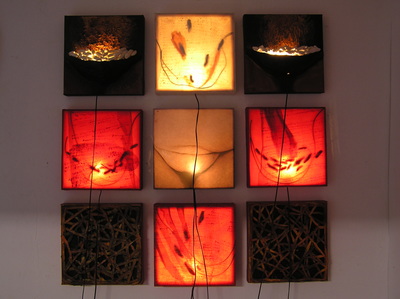Engrams of Oblivion
1997 | Galeria San Nicolo | Venice
Under the auspices of the Greek Consulate of Greece in Venice. Organized for the Venice Biennale 1997 (catalog)
Under the auspices of the Greek Consulate of Greece in Venice. Organized for the Venice Biennale 1997 (catalog)
«Ξυνον αρχη και περας επι κυκλου» - the Ephesian philosopher's notion that the origin and the end of the cycle merge, becomes the semantic focus of Halivopoulou who reflects on the perpetual flow and interchange of events such as life and death, culmination and decline.
F r o m : " E n g r a m s o f O b l i v i o n " c a t a l o g u e t e x t
In a wall construction separated into four series of isomorphic artworks she arranges photographic close-ups of penetrating anatomical details taken from a female body ravaged by time against light boxes which contain microorganisms, then against biomorphic reliefs composed of soil or sketches flooded with illegible script. The organic forms which spread across the two dimensional surfaces recall enlarged maps of flesh and allude to the biological functions of the body. In contrast the phrases, contained as simple morphological elements of the composition, wrap contort and unravel like thread indicating the complex web of human thought. The cables - umbilical cords or dendrites and neurons of the brain - are the connecting link between the wall construction and the semi transparent installation which floats in space, enclosing and incorporating in its walls an entire universe of visible artistic occurrences. Serving as grafts of existence, the filaments act metaphorically to weave material flesh with ethereal intellect, stressing the complementary relationship of the two as a condition for the balance of the whole. Halivopoulou describes the transmulation from being to nothingness and vice versa, thereby proposing timeless ideas on alteration, transformation, and the eternal motion of comsogonic energy.Using the human as a unit of the universe she emphasizes the mechanisms of sense and perception, indirectly invoking the gnoseological issue which pertains to external reality and the precise recognition of visual representation. Experiences convert into images which erase from memory only to reemerge unexpectedly as engrams of oblivion which chart their own independent course as they are etched and re-sketched on the human brain. In Halivopoulou's artworks primordial generative forces define the unification of beginning and end, thereby bearing the connection and convergence of opposites.
____________________________________
Bia Papadopoulou, Art Historian; Catalogue text, exhibition "Engrams of Oblivion" (excerpt) Galeria San Nicolo, Venice, 1997. Exhibition organized by the Consulate of Greece in Venice, for the Venice Biennale.
F r o m : " E n g r a m s o f O b l i v i o n " c a t a l o g u e t e x t
In a wall construction separated into four series of isomorphic artworks she arranges photographic close-ups of penetrating anatomical details taken from a female body ravaged by time against light boxes which contain microorganisms, then against biomorphic reliefs composed of soil or sketches flooded with illegible script. The organic forms which spread across the two dimensional surfaces recall enlarged maps of flesh and allude to the biological functions of the body. In contrast the phrases, contained as simple morphological elements of the composition, wrap contort and unravel like thread indicating the complex web of human thought. The cables - umbilical cords or dendrites and neurons of the brain - are the connecting link between the wall construction and the semi transparent installation which floats in space, enclosing and incorporating in its walls an entire universe of visible artistic occurrences. Serving as grafts of existence, the filaments act metaphorically to weave material flesh with ethereal intellect, stressing the complementary relationship of the two as a condition for the balance of the whole. Halivopoulou describes the transmulation from being to nothingness and vice versa, thereby proposing timeless ideas on alteration, transformation, and the eternal motion of comsogonic energy.Using the human as a unit of the universe she emphasizes the mechanisms of sense and perception, indirectly invoking the gnoseological issue which pertains to external reality and the precise recognition of visual representation. Experiences convert into images which erase from memory only to reemerge unexpectedly as engrams of oblivion which chart their own independent course as they are etched and re-sketched on the human brain. In Halivopoulou's artworks primordial generative forces define the unification of beginning and end, thereby bearing the connection and convergence of opposites.
____________________________________
Bia Papadopoulou, Art Historian; Catalogue text, exhibition "Engrams of Oblivion" (excerpt) Galeria San Nicolo, Venice, 1997. Exhibition organized by the Consulate of Greece in Venice, for the Venice Biennale.







